The Crucial BX300 (480GB) SSD Review: Back To MLC
by Billy Tallis on August 29, 2017 9:00 AM ESTRandom Read Performance
Our first test of random read performance uses very short bursts of operations issued one at a time with no queuing. The drives are given enough idle time between bursts to yield an overall duty cycle of 20%, so thermal throttling is impossible. Each burst consists of a total of 32MB of 4kB random reads, from a 16GB span of the disk. The total data read is 1GB.

The burst random read performance of the Crucial BX300 is better than the previous Crucial SSDs, but still trails behind quite a few other MLC SSDs and the two fastest 3D TLC SSDs.
Our sustained random read performance is similar to the random read test from our 2015 test suite: queue depths from 1 to 32 are tested, and the average performance and power efficiency across QD1, QD2 and QD4 are reported as the primary scores. Each queue depth is tested for one minute or 32GB of data transferred, whichever is shorter. After each queue depth is tested, the drive is given up to one minute to cool off so that the higher queue depths are unlikely to be affected by accumulated heat build-up. The individual read operations are again 4kB, and cover a 64GB span of the drive.

On a longer test of random read performance and with some higher queue depths in play, the Crucial BX300 ends up falling behind the MX200 but is substantially faster than the MX300 and most other TLC SSDs. Most of the MLC SSDs and the 3D TLC-based Samsung 850 EVO and Intel 545s significantly outperform the Crucial BX300.
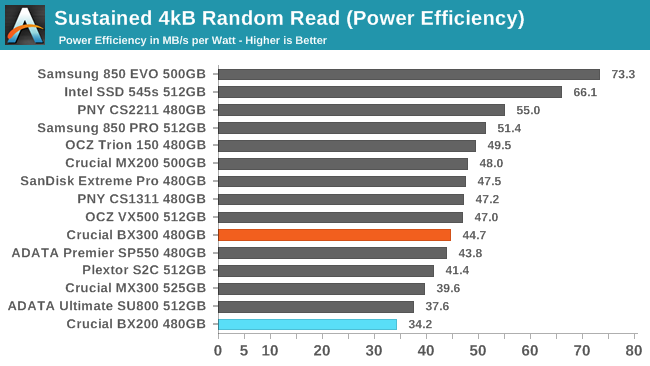
The power efficiency of the Crucial BX300 when performing random reads is a bit below average for SATA SSDs, with a few planar TLC SSDs beating it.
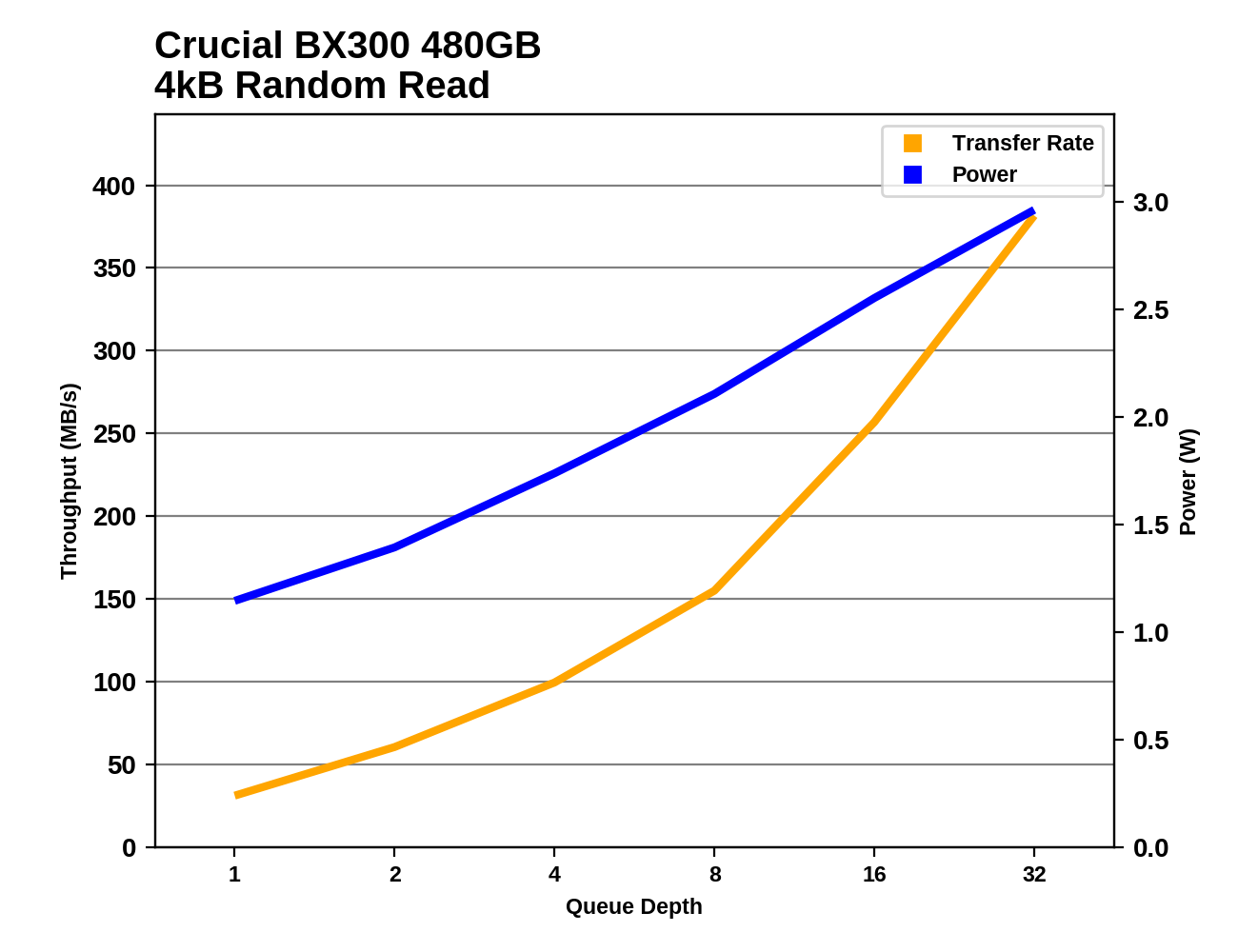 |
|||||||||
With a high enough queue depth, the Crucial BX300 delivers random read performance that is as good as any SATA drive of this capacity, but it also requires quite a bit of power to perform that well. At more modest queue depths, the BX300 underperforms most of its competition-especially the Samsung drives, which saturate at QD16.
Random Write Performance
Our test of random write burst performance is structured similarly to the random read burst test, but each burst is only 4MB and the total test length is 128MB. The 4kB random write operations are distributed over a 16GB span of the drive, and the operations are issued one at a time with no queuing.
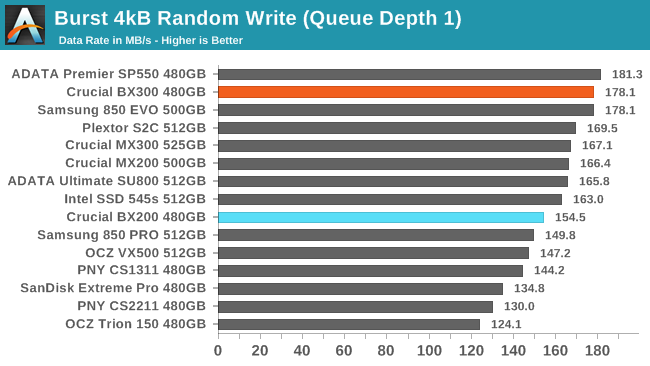
The Crucial BX300's QD1 burst random write performance is tied with the Samsung 850 EVO for second place, slightly behind the ADATA SP550 of all things. Crucial's MX300 is only about 6% slower, while the Samsung 850 PRO is about 16% slower.
As with the sustained random read test, our sustained 4kB random write test runs for up to one minute or 32GB per queue depth, covering a 64GB span of the drive and giving the drive up to 1 minute of idle time between queue depths to allow for write caches to be flushed and for the drive to cool down.
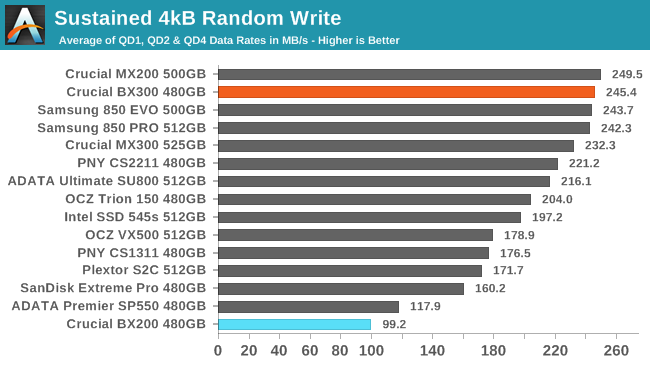
With a longer test duration and higher queue depths, the Crucial BX300 holds on to second place, this time scoring just behind the Crucial MX200. The Samsung 850s are just a hair slower than the BX300, and the Crucial MX300 is the next fastest.
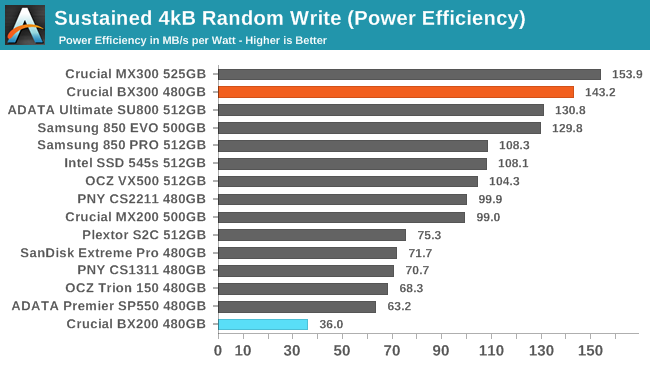
In terms of power efficiency during the random write test, the BX300 is again in second place, with the MX300 holding on to a safe lead. The BX200's efficiency was abysmal, and the BX300 provides four times the performance per Watt on this test.
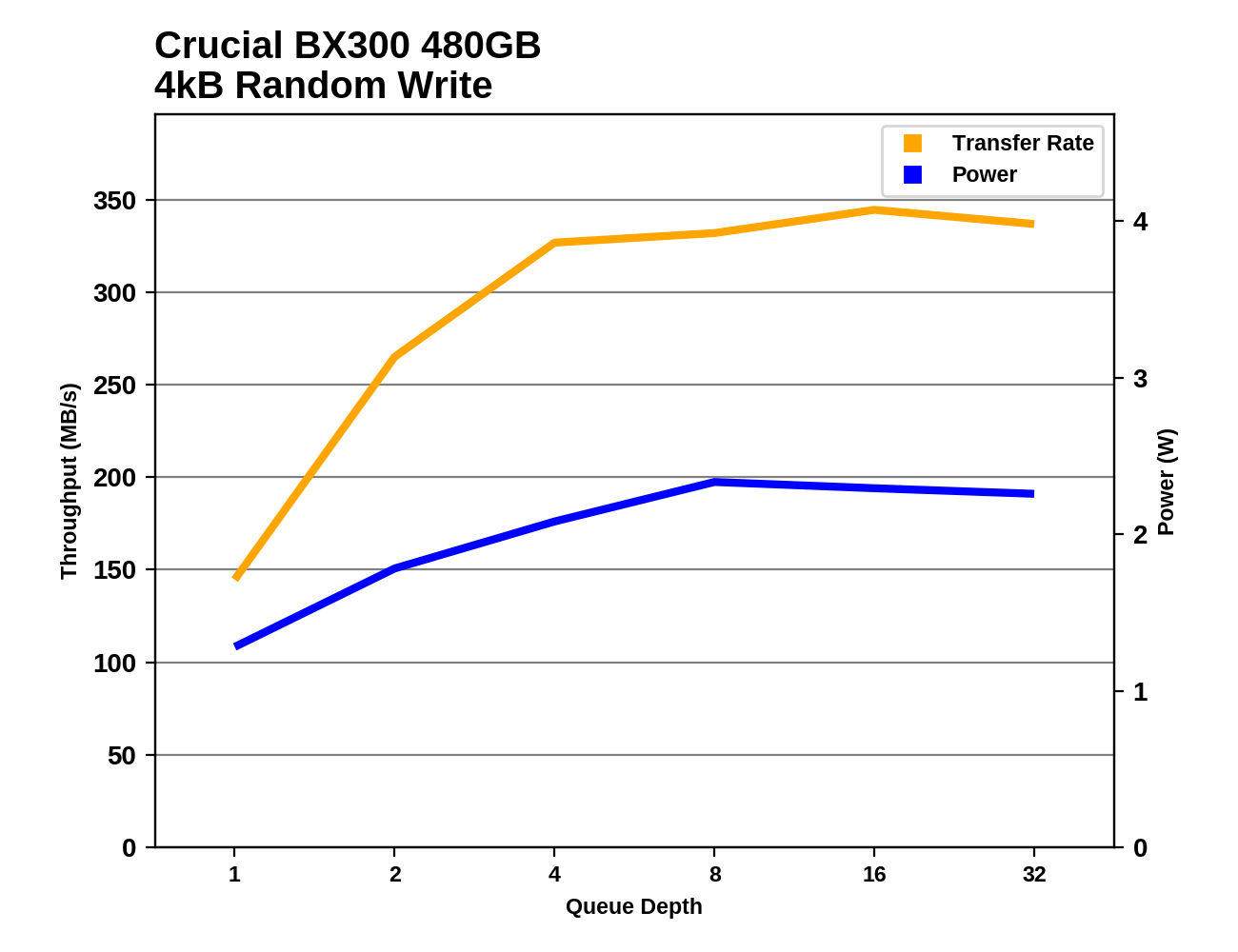 |
|||||||||
The Crucial BX300 scales to near saturation by QD4, but power consumption keeps increasing up to QD8. The performance curve for the MX300 is just below the BX300's, but the power consumption of the MX300 stays significantly lower and even the slowest drives end up drawing more power than the MX300.










90 Comments
View All Comments
nathanddrews - Tuesday, August 29, 2017 - link
SSD prices at Microcenter dropped by about 25% over the weekend (850 EVO 500GB for $139) and Amazon and Newegg are also down a bit, I assume the NAND shortage is over? Just clearing inventory? I'm really happy to see MLC back in the mix! Time to upgrade the last of the mechanical computers...ddriver - Tuesday, August 29, 2017 - link
Oh no it is not. They are gonna milk that cow until Chinese NAND gets to the market. And then they will short the price.On a side note, way to go Crucial - making quality products with MLC flash, with endurance worse than that of TLC flash. It is quite the achievement.
ddriver - Tuesday, August 29, 2017 - link
On the bright side, it is good to see that the competition is finally catching up to samsung SATA SSDs. Be that a couple of years after they stopped developing SATA SSDs.Yojimbo - Tuesday, August 29, 2017 - link
I think Chinese production of NAND and DRAM will be by new companies operating in new foundries. Volume production probably won't be reached until 2019, and can we really be sure of what to expect when it does?leexgx - Saturday, September 2, 2017 - link
you do know that endurance actually means warranty void if you use more than the endurance rating, MLC drives norm have endurance levels of PB of data before issues start to happenlove the BX100 for its near 0 power use when idle but it does choke a little under high load meaning i actually notice it slightly when its struggling but still its many times faster then a HDD witch can get tied up under medium loads (like windows update and store)
be nice if they can replicate that on the BX300 (should be better than the BX100 due to SLC cache and improved controller )
Ryan Smith - Tuesday, August 29, 2017 - link
The NAND shortage is definitely not over. That won't abate until some time in 2018.I couldn't say if it was clearing inventory, a short-term deal, or something else, but right now there's no reason to believe any kind of price cuts will stick.
nathanddrews - Tuesday, August 29, 2017 - link
So what you're saying is "get it while it's hot"?Ryan Smith - Wednesday, August 30, 2017 - link
Yup.BrokenCrayons - Tuesday, August 29, 2017 - link
I picked up a 480GB Muskin Reactor Armor3D for $139 _very_ recently dropped from $149. Like you, I was wondering if the NAND shortage was coming to an end, but Ryan is in a good position to know these things so maybe there's just a good deal on at the moment.Alexvrb - Tuesday, August 29, 2017 - link
MLC or not the TLC Evo is still the better performing drive. If you're buying a ~250GB model the Evo is hands down the best option. At 500GB-1TB capacities there are a couple of cheaper options that are tempting but the Evo is still the best deal for the money IMHO until you hit 2TB class drives, where the MX300 really shines.